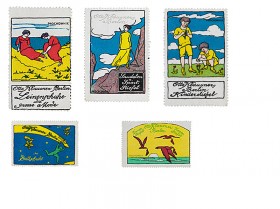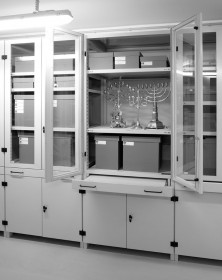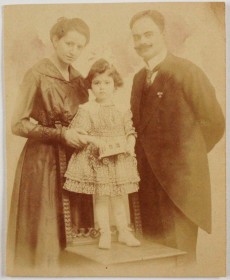
Five stamp-sized advertisements for the company Otto Klausner GmbH, Berlin, ca. 1910-1914. Gift of Peter-Hannes Lehmann
Like every museum, we have some objects in our collection that are always on display for our visitors, some that we show from time to time in temporary exhibitions, and also some that we rarely show because they are more suited to research purposes. And then there are objects that we should have put on view long ago but they are still sitting, out of sight, in our warehouse. It affords a particular pleasure when such items finally get processed for our online database and put on display.
A collection that falls into this category is a set of graphics by Leo Prochownik (1875 – 1936) → continue reading

View of Jewish Musem-Berlin storage,© Jewish Museum Berlin, photo: Jens Ziehe
It’s cold. The neon light casts a harsh glare. A gray cabinet stands next to another along white walls. The room feels sterile. The air conditioning hums. A gloomy place.
I put on blue, latex gloves, open one of the cabinets and take out a gray carton. Contours of an item shimmer from under layers of tissue paper. Carefully, I take the object out of the carton and free it from the paper; a microcosm of history presents itself, as if this gloomy place accentuates the aura of the item, the room itself taking a whole step back. → continue reading
Shortly after the opening of our temporary exhibition “Snip it!”, the Jewish Museum received as a bequest the estate of Fritz Wachsner (1886 – 1942). Included in this delivery was a bundle of letters so enormous that I didn’t have time, in creating an inventory, to delve into each individual piece. But one letter caught my attention. “[…] Your assessment of the circumcision issue […]”, wrote Wachsner on 24. July 1919 to his – then very pregnant – wife Paula’s uncle Anselm Schmidt (1875 – 1925). I read on and suddenly found myself in the middle of a nearly one-hundred-year-old internal Jewish debate on circumcision.

Fritz Wachsner with his wife Paula and their first-born child, Charlotte, studio portrait, ca. 1916 © Jewish Museum Berlin, photo: Jörg Waßmer, Gift of Marianne Meyerhoff
At the time, Fritz Wachsner was 33-year-old teacher in the town of Buckow in Brandenburg. In the five-page letter he clarifies the reasons for his hostile stance towards the Bris. He was an assimilated German Jew and belonged to a Reform Jewish congregation. As he explains to his uncle, he was “raised fairly orthodox” but, in the course of his university studies in Berlin and Jena as well as at the Academy for the Study of Judaism in Berlin, he learned “to know and appreciate the spirit of Judaism freed from every non-German embellishment”. He became persuaded that the religion should evolve continually and be “modernized and improved”. Wachsner’s maxim was: “Become German, outside as well as inside the religious community”, the overtones of which are especially → continue reading


